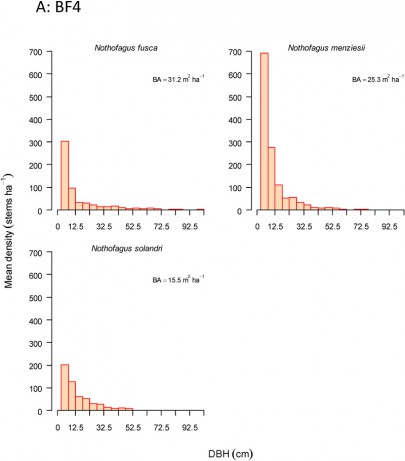Nothofagus menziesii - N. fusca - N. solandri forest
In this section
Common name: Silver beech – red beech – black/mountain beech forest Code: A: BF4
Where does it occur?
This alliance is geographically restricted (144 000 ha) and was sampled only on the South Island where it is found north of Arthur’s Pass and south of Lake Wakatipu. Sites range in altitude from 380–1200 m and occur on gentle to steep slopes in a range of topographic positions.
Description
The forest is dominated by Nothofagus menziesii, N. fusca, and N. solandri. This class is unusual in that these are the only three species that occurred in the canopy above 5 m, and these species are also the most frequently occurring species and have the highest average cover through all height tiers from 0 to 5 m.
This class is characterised by a relatively high richness of fern species, the most frequent being Grammitis billardierei, Asplenium flaccidum and Hymenophyllum villosum, with less frequent occurrences of Grammitis magellanica, Hymenophyllum sanguinolentum, H. multifidum, Blechnum procerum and B. discolor. In the subcanopy there are occasional occurrences of Coprosma colensoi, C. microcarpa, C. tayloriae and Cyathea colensoi. Below 0.3 m broadleaf is the next most frequent species and occurs on 25% of the plots. The orchids Adenochilus gracilis and Corybas trilobus occur at similar frequency. Species richness is low with on average 12 species per plot, with five of these being measurable trees. No exotic species were found on any of the plots. This alliance has low vulnerability to goat, deer and possum browse; it has a very low proportion of species selected by goats, deer and possums of any class and a high proportion of goat-avoided species

A: BF4 size structure of canopy dominants.
Indicator species
Co-occurrence of Nothofagus fusca, Nothofagus menziesii and Nothofagus solandri.
Stand characteristics
| Mean canopy height (m): | 22 m (range 10–38) |
| Mean stem density (stems/ha): | 2453 (241) |
| Mean basal area (m2/ha): | 73 (5.8) |
Regeneration of canopy dominants
Within stands, the shade-tolerant N. menziesii has > 30 times as many small-diametered trees as large ones, compared to < 15 times as many for the other Nothofagus species; N. menziesii is also more frequent across all plots.This suggests that, in the absence of major disturbance, N. menziesii will increase in relative dominance in the future.
Synonyms
| Relationship | Name | Author |
|---|---|---|
| is included within | Red, silver beech forest | Singers & Rogers (unpublished) |
| overlaps with | [p. 143] Beech forests: northern South Island | Wardle (1991) |
| overlaps with | [p. 147] Beech forests: Central and southern South Island | Wardle (1991) |
| overlaps with | [p. 152] Beech forests: North Island axial ranges | Wardle (1991) |
| overlaps with | [p. 155] Beech forests: other beech stands of the North Island | Wardle (1991) |
| is included within | Red, silver beech forest | Singers & Rogers (unpublished) |
Nothofagus fusca – N. menziesii / Grammitis billardierei forest
Common name: Red – silver beech forest with strap fern
Code: a: BF14
Where does it occur?
This 68 000 ha association has most often been sampled on the western South Island north of Arthur's Pass.Scattered examples also occur in Southland and Fiordland and in the North Island in the Aorangi, Kaimanawa, Kaweka and Urewera Ranges. Sites range from flat to very steeply sloping (60º). Altitudes range from 370 to 1200 m.
Description
Besides the nominal species, there are no other species that occur in more than half of the stands of this association. On average stands are 22 m tall, but may be up to 38 m tall.These forests are relatively species poor with, on average, 13 species, but can be as many as 32, recorded on a plot, of these fewer than 1% are exotic, on average.
Nothofagus fusca – N. solandri – N. menziesii forest
Common name: Red – black/mountain – silver beech forest
Code: a: BF15
Where does it occur?
This 75 600 ha association has been sampled only from the South Island from north-west Southland and from Arthur's Pass northwards. Sites range from flat to steeply sloping (60º) with altitudes ranging from 320 to 1180 m.
Description
This forest association is, on average, 21 m tall but can range from 11 to 35 m. It tends to be species-poor with an average of 12 species on a plot which can reach 25. No exotic species were recorded on these plots.
![A sparse understorey is characteristic of the [Nothofagus fusca]– [Nothofagus menziesii] / [Grammitis billardierei] forest association. Cobb Valley, Kahurangi National Park. Image](/assets/Publications/Woody-ecosystem-types/sparse_understorey_characteristic_Nothofagus_fusca_N_menziesii_Grammitis_billardierei__FitMaxWzE1LDE1XQ.jpg)
![[Grammitis billardierei] is the only understorey species that occurs in more than half of the stands of this association. Cobb Valley, Kahurangi National Park. Image](/assets/Publications/Woody-ecosystem-types/Grammitis_billardierei_understorey_species__FitMaxWzE1LDE1XQ.jpg)
![[Nothofagus fusca]– [Nothofagus menziesii] / [Grammitis billardierei] forest. Cobb Valley, Kahurangi National Park. Image](/assets/Publications/Woody-ecosystem-types/Nothofagus_fusca_N_menziesii_Grammitis_billardierei_forest__FitMaxWzE1LDE1XQ.jpg)
References
Wiser, S.K., Hurst, J.M. 2010. Composition and structure of 24 New Zealand forest and shrubland vegetation communities. Landcare Research Contract Report LC0910-073. Prepared for the Department of Conservation and the Sustainable Management Fund of the Ministry of Agriculture and Forestry.
Wiser, S.K., J.M. Hurst, R.B. Allen, E.F. Wright. 2011. New Zealand’s forest and shrubland communities: a classification based on a nationally representative plot network. Applied Vegetation Science 14: 506-523.
Wiser, S.K.; De Cáceres, M. 2013. Updating vegetation classifications: an example with New Zealand's woody vegetation. Journal of Vegetation Science 24: 80-93.
De Cáceres M, Legendre P, Wiser SK, Brotons L (2012) Using species combinations in indicator value analyses. Methods in Ecology and Evolution 3(6): 973-982.


